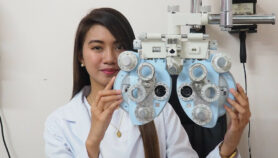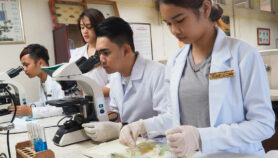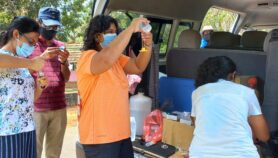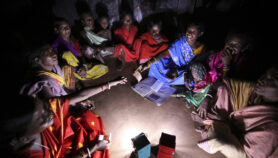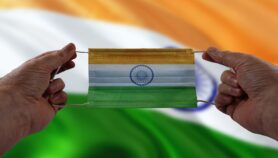By: T.V. Padma
Send to a friend
The details you provide on this page will not be used to send unsolicited email, and will not be sold to a 3rd party. See privacy policy.
T. V. Padma takes a look at methods that are helping the developing world’s blind people see again, and helping them live more easily.
The magnitude of blindness-related problems in developing countries is often missed among reports on epidemics or other public health problems.
Yet in 2002 the WHO estimated that there were around 37 million blind people worldwide and an additional 124 million with very low vision. Ninety per cent of the visually impaired are in developing countries.
South and South-East Asia account for the highest percentage of avoidable blindness (28 per cent), followed by the western Pacific (26 per cent), Africa (16.6 per cent) and the eastern Mediterranean (10 per cent).
In the United Kingdom and the United States fewer than 3 out of 10,000 children are blind at birth, whereas in India — home to the largest number of blind children in the world — there are more than eight.
But new technology is being employed to treat blindness and make life easier for the blind in developing countries. From satellites to new software, sophisticated cornea transplants and experimental stem cell transplants, things are looking up.
The roots of blindness
In 2000 the UK-based International Agency for Prevention of Blindness (IAPB) estimated the global cost of blindness and low vision at US$42 billion, a cost they said could rise to US$110 billion by 2020 if there is no decline.
The WHO notes that in spite of improvements in eye surgery over the last ten years, cataract — where the clear lens of the eye turns cloudy — remains the leading cause of visual impairment in developing countries, accounting for 47 per cent of cases.
A major cause of cataract is exposure to ultraviolet radiation, a consequence of the tropical environment of many developing countries.
Other major causes are glaucoma — in which excess pressure damages the optic nerve — (12.3 per cent), age-related degeneration (8.7 per cent), the cornea turning opaque (5.1 per cent), retina damage due to diabetes (4.8 per cent) and childhood blindness (3.9 per cent).
Trachoma — a contagious inflammation of the eye by the bacterium Chlamydia trachomatis — and eye injuries are also common.
In most cases, blindness results from lack of access to eye healthcare and vision-correcting aids. The IAPB notes that perhaps one of the "saddest examples" is in Africa, where hundreds of thousands of children are treated for blindness caused by a lack of skilled eye care services to detect and correct faulty vision, or their families being too poor to buy prescribed spectacles.
 |
| Blind children queue for water in Tanzania |
| Credit: Flickr/urban penguin |
In Bangladesh and India thousands suffer severe eye damage every year due to chemical injuries in the workplace, or from the lime paste that is added to betelnut leaves, a popular stimulant. Lime paste is rubbed onto leaves that are then chewed, and people often accidentally touch their eyes afterwards.
A study in 2003 by the L. V. Prasad Eye Institute (LVPEI) — a WHO collaborating centre for blindness in Hyderabad, India — and the University of Melbourne in Australia found that in the state of Andhra Pradesh in southern India, one in 150 Indians suffer from blindness in the cornea, the outer layer that covers the iris and the pupil.
Ninety-five per cent of the cases were avoidable and caused by injury from thorns, branches, plant secretions and chemicals.
And a 2001 study by the Tribhuvan Institute of Medicine and Teaching Hospital in Nepal, in collaboration with the US-based University of California, found that Nepal has seven times more corneal ulcers than southern India, and 70 times more than the United States.
Eye injuries and corneal ulcers are "serious public health problems that are occurring in epidemic proportions in Nepal," it concluded.
Vision 2020
In 1999 the WHO and the IAPB launched the ‘Vision 2020: Right to Sight’ programme, aiming to decrease the number of blind people worldwide by 2020 from the projected 75 million to 24 million.
Health agencies are also trying to spread awareness about early detection and prevention of the conditions that lead to blindness. This has led to impressive results in the Gambia, India, Morocco, Nepal, Sri Lanka, Thailand and other countries that have organised early detection camps for cataract, eye ulcers and cancers, low-cost cataract operations and vitamin A supplementation programmes, says the IAPB.
One such success story is Nepali eye surgeon Sanduk Ruit, who won the Ramon Magsaysay award — Asia’s equivalent of the Nobel Prize — in 2006 for his efforts to bring sutureless cataract surgery to Nepal.
Ruit is medical director of the Tilganga Eye Centre in Kathmadu, which operates an eye bank that collects donated corneas for transplantation and makes high-quality lenses for implantation into cataract patients. These lenses are an affordable US$5 apiece and are available in over 50 countries. But a lot needs to be done. "Cataract blindness continues to pile-up, particularly in developing nations and unprivileged societies," says Ruit.
Ruit also runs mobile ‘eye camps’ in remote areas, as far afield as Bangladesh, Cambodia, China, India and North Korea.
Eye operations are becoming increasingly affordable in developing countries. Cataract surgery — in which the clouded opaque lens of the eye is replaced with a clear one — is now routine.
And corneal transplants — replacing the damaged cornea with a donated one — are now increasing. LVPEI performs 900–1000 transplants each year on patients from south and west Asia, some of which are free for those who cannot afford to pay.
   |
| A cornea is removed from an eye for transplant |
| Credit: LVPEI |
In cases where new corneas fail to graft properly, artificial corneas made of biocompatible plastics are used.
However, in some cases corneal transplants are of no help because of damage to the corneal limbus, an area at the edge of the cornea which gives rise to corneal cells.
LVPEI scientists are studying the potential of stem cells — unspecialised cells in the body that can become specific cells such as heart, muscle and nerve cells — to regenerate the limbus.
Under a project funded by India’s Department of Biotechnology in 2001, LVPEI scientists cultured adult stem cells taken from a patient’s limbus in a special medium and then transplanted them back into the patient’s eye.
The project began with 20 patients but expanded to over 500 stem cell transplantations, says Geeta Vemuganti, head of the stem cell laboratory at LVPEI.
A follow-up of the first 200 patients showed that in 40 per cent of cases, the transplanted limbal cells helped re-grow the cornea. The remaining needed an additional corneal transplant.
Research and rehabilitation
Dorairajan Balasubramaian, LVPEI director, says stem cells are one of two "whiffs of hope" for new treatments.
Stem cells derived from a patient’s bone marrow are being used to grow retina cells, and another option is the use of gene therapy to correct blindness caused by a defective retinal gene.
Scientists in the US are also testing artificial silicon retinas in blind patients with damaged retinas to see if they can stimulate vision. The solar-powered chips convert light into electrical pulses that stimulate damaged retinal cells, allowing them to send visual signals to the brain.
The US-based Massachusetts Institute of Technology has launched ‘Project Prakash’ — prakash means ‘light’ in Sanskrit — to develop computational models for face detection skills.
They are working with a group of Indian children whose sight has been restored after treatment to understand how the brain sees and recognises objects and faces, and hope the model can be used in rehabilitation programmes once sight is restored.
Making life easier
But it’s not just about surgical correction. Other projects are helping the developing world’s blind make the best of life with their condition.
The Blind People’s Association in Ahmedabad, Gujarat, in India, promotes education, training, employment and community-based rehabilitation services for the blind. In a recent innovative project, they’ve turned to India’s education satellite EDUSAT for help.
EDUSAT, launched by the Indian Space Research Organisation (ISRO) in September 2004, beams long-distance primary education programmes to 10,000 classrooms in remote areas across India and provides connectivity to schools, colleges and higher institutes, along with supporting home schooling and distance learning.
The Blind People’s Association approached ISRO to help set up a special network for blind students.
"The satellite network has proved to be an economical and viable alternative in areas where teachers for blind students come only twice a week and most schools do not have experts to teach such children," says Bharat Darji, deputy project director at ISRO’s Space Applications Centre in Ahmedabad.
Using EDUSAT, ISRO relays both educational audio programmes and data that can be read with Braille to over 800 blind children in ten remote sites in Gujarat.
Darji told SciDev.Net there is scope to expand the network to 40 blind schools in Gujarat and implement it in other Indian states.
Similar advances in software and medicine are helping rehabilitate people with impaired eyesight, who find it difficult to read or see clearly.
Information technology offers a tremendous opportunity to improve education and employment for the visually challenged, say scientists at LVPEI.
Examples include software that magnifies text and icons on the computer screen up to 16 times; allows a speech synthesiser to ‘speak’ the text displayed on the screen; prints Braille output from a computer by punching dots on to paper; and edits letters, emails and text written in Braille.
For people with low vision, the Low Vision Resource Centre at the Hong Kong Society for the Blind has an inventory of over 120 low-vision devices under US$7, including binocular telescopes, magnifiers and ‘glare control’ lenses fitted with special filters.
They also have a range of non-optical devices to help those with poor vision live independently, such as high-contrast watches, magnifying mirrors, needle threaders and large print books.
But experts point out that any life-enhancing measures need to be complemented with robust eye health awareness programmes to prevent and treat blindness if the developing world is to slow its spiralling blindness levels.
"Sight restoration has to be of first class quality, always and everywhere," says Ruit, emphasising that no-one should receive second-class treatment.




